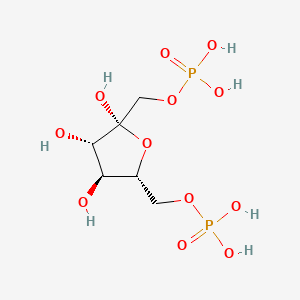



1. Fructose 1,6-bisphosphate
2. Fructose 1,6-diphosphate
3. Fructose-1,6-diphosphate
4. Fructose-1,6-diphosphate Magnesium Salt
5. Fructose-1,6-diphosphate, (alpha-d)-isomer
6. Fructose-1,6-diphosphate, (beta-d)-isomer
7. Fructose-1,6-diphosphate, (l)-isomer
8. Fructose-1,6-diphosphate, 2-(18)o-labeled
9. Fructose-1,6-diphosphate, Barium (1:2) Salt
10. Fructose-1,6-diphosphate, Calcium (1:2) Salt
11. Fructose-1,6-diphosphate, Calcium Salt
12. Fructose-1,6-diphosphate, Disodium Salt
13. Fructose-1,6-diphosphate, Monosodium Salt
14. Fructose-1,6-diphosphate, Sodium Salt, Monohydrate
15. Fructose-1,6-diphosphate, Tetrapotassium Salt
16. Fructose-1,6-diphosphate, Tetrasodium Salt
17. Fructose-1,6-diphosphate, Trisodium Salt
18. Sr-fdp
19. Strontium Fructose 1,6-diphosphate
20. Strontium Fructose-1,6-diphosphate
1. Beta-d-fructose 1,6-bisphosphate
2. Fructose-1,6-diphosphate
3. Beta-d-fructofuranose 1,6-bisphosphate
4. Beta-fructose-1,6-diphosphate
5. 34693-15-7
6. Fbp
7. Fructose 1,6-diphosphate
8. Chebi:28013
9. Fructose 1,6-bisphosphate
10. Fructose-1,6-bisphosphate
11. D-fructose-1,6-diphosphate
12. Esafosfan
13. Beta-d-fructofuranose 1,6-bis(dihydrogen Phosphate)
14. Diphosphofructose
15. [(2r,3s,4s,5r)-2,3,4-trihydroxy-5-(phosphonooxymethyl)oxolan-2-yl]methyl Dihydrogen Phosphate
16. D-fructose 1,6-biphosphate
17. 488-69-7
18. Ncgc00166321-01
19. Fructose Bisphosphate
20. Fructose 1,6-bis
21. Esafosfina
22. Beta Fructose 1,6-diphosphate
23. 1bo5
24. Bmse000011
25. Wch874xlb1
26. D-fructose 1,6-diphosphate
27. D-fructose-1,6-bisphosphate
28. Chembl97893
29. Schembl168244
30. .beta.-d-fructofuranose, 1,6-bis(dihydrogen Phosphate)
31. Dtxsid0048347
32. Beta-d-fructose-1,6-diphosphate
33. .beta.-d-fosfructofuranose
34. Zinc4096694
35. Einecs 251-977-7
36. Db04551
37. C05378
38. .beta.-d-fructofuranose 1,6-diphosphate
39. Q414945
40. Beta-d-fructofuranose, 1,6-bis(dihydrogen Phosphate)
41. Beta-d-fructofuranose 1,6-bisphosphate (rssr Closed Ring)
42. 16eb39bb-b854-429f-972f-0d8401178a36
43. Wurcs=2.0/1,1,0/[ha122h-2b_2-5_1*opo/3o/3=o_6*opo/3o/3=o]/1/
| Molecular Weight | 340.12 g/mol |
|---|---|
| Molecular Formula | C6H14O12P2 |
| XLogP3 | -5.6 |
| Hydrogen Bond Donor Count | 7 |
| Hydrogen Bond Acceptor Count | 12 |
| Rotatable Bond Count | 6 |
| Exact Mass | 339.99604987 g/mol |
| Monoisotopic Mass | 339.99604987 g/mol |
| Topological Polar Surface Area | 203 Ų |
| Heavy Atom Count | 20 |
| Formal Charge | 0 |
| Complexity | 428 |
| Isotope Atom Count | 0 |
| Defined Atom Stereocenter Count | 4 |
| Undefined Atom Stereocenter Count | 0 |
| Defined Bond Stereocenter Count | 0 |
| Undefined Bond Stereocenter Count | 0 |
| Covalently Bonded Unit Count | 1 |
Anti-Arrhythmia Agents
Agents used for the treatment or prevention of cardiac arrhythmias. They may affect the polarization-repolarization phase of the action potential, its excitability or refractoriness, or impulse conduction or membrane responsiveness within cardiac fibers. Anti-arrhythmia agents are often classed into four main groups according to their mechanism of action: sodium channel blockade, beta-adrenergic blockade, repolarization prolongation, or calcium channel blockade. (See all compounds classified as Anti-Arrhythmia Agents.)
Cardiovascular Agents
Agents that affect the rate or intensity of cardiac contraction, blood vessel diameter, or blood volume. (See all compounds classified as Cardiovascular Agents.)
Immunologic Factors
Biologically active substances whose activities affect or play a role in the functioning of the immune system. (See all compounds classified as Immunologic Factors.)
Neuroprotective Agents
Drugs intended to prevent damage to the brain or spinal cord from ischemia, stroke, convulsions, or trauma. Some must be administered before the event, but others may be effective for some time after. They act by a variety of mechanisms, but often directly or indirectly minimize the damage produced by endogenous excitatory amino acids. (See all compounds classified as Neuroprotective Agents.)
C - Cardiovascular system
C01 - Cardiac therapy
C01E - Other cardiac preparations
C01EB - Other cardiac preparations
C01EB07 - Fructose 1,6-diphosphate